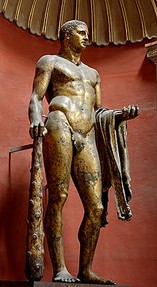 In David Rankine and Sorita D'Este's excellent book The Isles of Many Gods, the Cerne Abbas Giant is amongst those listed (p157). This is 'an A-Z of the Pagan Gods and Goddesses worshiped in Ancient Britain during the First Millennium CE through to the Middle Ages'.
In David Rankine and Sorita D'Este's excellent book The Isles of Many Gods, the Cerne Abbas Giant is amongst those listed (p157). This is 'an A-Z of the Pagan Gods and Goddesses worshiped in Ancient Britain during the First Millennium CE through to the Middle Ages'.
For them, and for everyone protesting the Homer Simpson incident from a Pagan viewpoint, the figure on the hillside is Helis, aka Helith.
Their cited source is HJM Green's archaeological research for Oxford University, which was published in Pagan Gods and Shrines of the Roman Empire (1984).
He concluded that there was undoubtedly a God local to Cerne Abbas called Helis. He also observed that people in the local towns and villages still referred to the chalk figure as Helis.
Green then speculated that Roman invaders had imported their God Hercules into the British Isles. The native Celts had then Cymrized the name into Helis and that was who was etched into the chalk.
This theory was given a further boost in 1997, when a geological survey revealed that the Cerne Abbas Giant has changed over the years. He used to have a cloak draped over his arm too, as well as a severed head at his feet. As you can see in the image of Hercules above, the knotted club and cloak are certainly associated with him.
(Incidentally, Cerne Abbas Giant didn't used to have such a large phallus either. He had a distinct circle as a naval, which eventually became merged with his previously smaller erection.)
Unfortunately, all of this is largely circumstantial evidence, based too strongly on oral history. There is nothing wrong with the latter, until you realize that Helis or Helith has a better etymology in Saxon lore and they never met the Romans in Britain.
In the 16th century, John Leland visited St Augustine's Well, in nearby Cerne Abbey. He found that the spring was known for its restorative properties; and that it had originally been dedicated to Helith, a Saxon God or Goddess. The name comes from the same root as the word 'health'.
After the Norman conquest, Gotselin the Frenchman became Archdeacon of Canterbury. He used the position to study the life of St Augustine. In 1099, Gotselin completed his Historia Translationis St Augustini, which discussed the saint's evangelism in the Cerne Valley.
The locals worshiped Hegle or Heil. Statues of the God (or Goddess) lined the well. But Augustine smashed them all before converting the 'Heathens' into Christianity. The spring was renamed there and then as St Augustine's Well. Gotselin cited an unnamed Saxon source, which dated that as occurring around 603 CE.
All of this very firmly places Helis (or a variation of the name) in the area right at the foot of Giant's Hill. We can be certain that the deity was worshiped in the Cerne Valley before the coming of Christianity.
What none of it does is point categorically to the chalk figure upon the hill and state, "That is Helis."
The deity in question was apparently associated with water and, in Britain, those tend to be Goddesses. The person outlined on the hill is very, very obviously masculine.



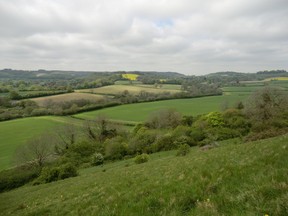 The Dorset countryside is unassumingly beautiful. Rolling hills, once formed beneath a prehistoric sea, now fill the landscape clad in green fields and trees.
The Dorset countryside is unassumingly beautiful. Rolling hills, once formed beneath a prehistoric sea, now fill the landscape clad in green fields and trees.
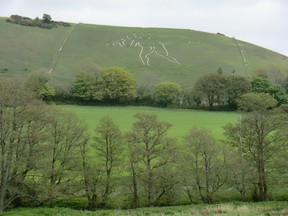 Once every twenty-five years, National Trust gardeners make the trek up onto Giant's Hill and begin to dig into the soil.
Once every twenty-five years, National Trust gardeners make the trek up onto Giant's Hill and begin to dig into the soil.



 In David Rankine and Sorita D'Este's excellent book The Isles of Many Gods, the Cerne Abbas Giant is amongst those listed (p157). This is 'an A-Z of the Pagan Gods and Goddesses worshiped in Ancient Britain during the First Millennium CE through to the Middle Ages'.
In David Rankine and Sorita D'Este's excellent book The Isles of Many Gods, the Cerne Abbas Giant is amongst those listed (p157). This is 'an A-Z of the Pagan Gods and Goddesses worshiped in Ancient Britain during the First Millennium CE through to the Middle Ages'. Every attraction website from the National Trust to the Dorset Tourist Board tells visitors that the Cerne Abbas Giant possibly dates from the 2nd century CE.
Every attraction website from the National Trust to the Dorset Tourist Board tells visitors that the Cerne Abbas Giant possibly dates from the 2nd century CE.



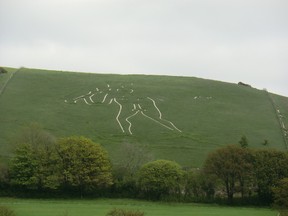 If we're absolutely honest, then seeing the chalk figure from above is the most perfect view of all. The fact that he's facing the sky has led some to theorize that Cerne Abbas Giant is a sky god.
If we're absolutely honest, then seeing the chalk figure from above is the most perfect view of all. The fact that he's facing the sky has led some to theorize that Cerne Abbas Giant is a sky god.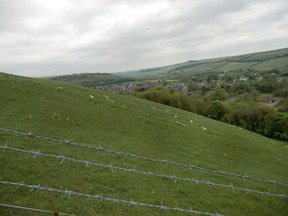 If it's any consolation, the best views of the giant have already been left behind in the car-parks and picnic area. Up above the carving is too close. You can see it well enough, but you can make no sense of what you're seeing. They're just so many chalky white lines.
If it's any consolation, the best views of the giant have already been left behind in the car-parks and picnic area. Up above the carving is too close. You can see it well enough, but you can make no sense of what you're seeing. They're just so many chalky white lines.




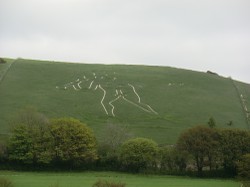

 St Tydecho's Churches in West Waleson 09/03/2014
St Tydecho's Churches in West Waleson 09/03/2014
 Goodies for an Outlander Premiere Partyon 03/06/2015
Goodies for an Outlander Premiere Partyon 03/06/2015
 Holocaust Memorial Day Interview with Rainer Höss, Grandson of Rudolf Architect of Auschwitzon 01/24/2015
Holocaust Memorial Day Interview with Rainer Höss, Grandson of Rudolf Architect of Auschwitzon 01/24/2015
 Romantic Valentine Gifts for an Outlander Fanon 01/16/2015
Romantic Valentine Gifts for an Outlander Fanon 01/16/2015



Comments
Your Dad sounds absolutely amazing! What an imagination to have!
I grew up in Dorset and my dad used to tell us lots of stories, basically taking bits of folklore and legends and then mixing them up with a little storytelling flair. In his story the Cerne Abbas Giant was an actual giant and is responsible for a number of names of villages in Dorset ie Puddletown was where rain gathered in one of his footprints and as for the 'Piddle' villages - you can imagine what they represented! I forget how in his story the giant became 'trapped' as a chalk figure, but it was entertaining. Sometimes it's nice to have a little mystery about the actual origins :)
You're very welcome. :)
At one time, they experimented with just having sheep up there to keep the grass trim. It didn't work so well, so now it's human beings every 25 years re-cutting the lines.
I love that even now, people still go up there to maintain this beautiful (if a little phallic) piece of history.
Thanks for explaining why there's this huge picture of a naked guy carved into our countryside!
I'm intrigued by the thought that the bonfire might have been in the Trendle. I know that it's been used for a long time for May Pole dancing. Summer solstice is just around the corner, so they could possibly have been getting ready for that.
Unless, of course, it was just burning random stuff while landscaping!
Thanks for your comment.
I agree the best view is from the main road but the views from up there are stunning . I was there over the weekend and noted a bonfire all ready in the neighbouring field. I would love to be there for that
Thank you very much.
In that case, you might be better off visiting one of the thirty or so less phallic chalk hill figures in the country. The vast majority are horses galloping across slopes.
Either that or climb up beside the Cerne Abbas giant and look at the landscape from his viewpoint. It is, indeed, very beautiful.
Sorry, but I'd hate to see that figure disrupting beautiful scenery. As always Jo, you've written an interesting page.
:D Yes, I can so see that. LOL
Looks to me like his nose was too big and slipped down his chest, over the years.